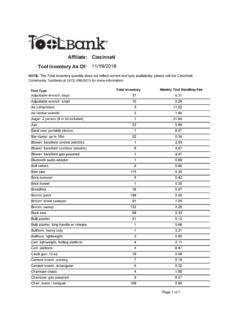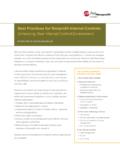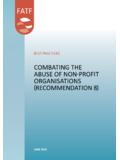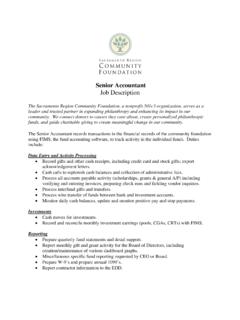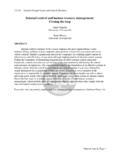Transcription of Best Practices in Financial Controls - ToolBank
1 best Practices in Financial Controls Length of session recommendation: 90 minutes Audience: EDs and Board Members Facilitator: Chris Darling, UPS, Susan K. Miller, CPA, and Susan Kenney, CPA This session will cover specific areas that Executive Directors, staff, and boards should know about their financials. It will help you understand what you are required to do and what is recommended, and what effective management Practices will help maintain Financial health and proper accountability. Financial Internal Controls and Accountability Risk and Fraud Why are internal Controls so important? As the system of policies and procedures that protect the assets of an organization, this discussion will set the tone for the session. We will discuss the importance of reliable Financial reporting, compliance with laws and regulations, and effective and efficient operations, in order to mitigate risk or liability.
2 Audits and the Audit Committee The word audit often produces panic, fear, and uncertainty. Yet audits are simply a factor in providing proper Financial management oversight of an organization. Discover what audits are and how audits can help you improve your operations and better serve your mission. Finance Controls best Practices Review of standard finance Controls - procedures followed by successful organizations to help them safeguard assets and ensure their reputations remain above reproach. Nonprofit Financial Reports Learn how the four primary Financial reports produced: Statement of Financial Position (Balance Sheet), Statement of Activities (Income Statement), Functional Expense Schedule (required for most organizations similar to the ToolBank ), and Statement of Cash Flows, interrelate and how your operational decisions impact them. How are the Financial statements for nonprofit organizations similar and different from those of for-profit organizations?
3 In-Kind Description and Valuation Nonprofits are often the recipients of donations of goods and services, and must report the value of these gifts on their Financial statements. In-kind value may be determined by the donor or by the nonprofit organization, and booked as such. Review of how in-kind should be represented on Financial statements and IRS requirements. Tool Depreciation Tool Depreciation is of particular concern to our ToolBanks. We will review a recommended calculation for depreciating tools in inventory if you are not already doing so. QUESTIONS Financial Internal Controls & AccountabilityChris DarlingFebruary 201616 Internal Controls are policies and procedures that protect the assets of an organization, create reliable Financial reporting, promote compliance with laws and regulations, and facilitate effective and efficient operations. It is important to form internal Controls for: Handling funds received and expended by the organization Preparing appropriate and timely Financial reporting Conducting a minimum of annual audits of Financial statements and core processes Evaluating staff and programs Maintaining inventory records of real and personal property Implementing personnel and conflict of interest policies Internal Controls & Accountability 16 Core Processes & Key ControlsAt the center of all business processes the key Controls are quality, accuracy and timeliness 16 QualityTimelinessAccuracyBillingCollecti onsAccounts ReceivableAccounts PayablePayroll AuditGeneral Ledger On average typical organizations can lose 5% of annual revenue to fraud.
4 Fraud schemes in nonprofits can include check fraud, embezzlement, ghost employees, expense fraud, misappropriation of funds for personal use, fictitious vendor schemes, kickbacks from unscrupulous vendors, and outright theft of cash or assets Beyond Financial loss however, an even greater potential cost of fraud to non profit organizations is the reputational damage that can occur At the same time, non profits are especially vulnerable to fraud Many times, employees are volunteers who are passionate about the mission, but may not be well versed in Financial issues and internal Controls Many nonprofits distribute grants, scholarships, awards, or other types of Financial aid to outside agencies or individual recipients Nonprofits with small staff often make segregation of duties more difficult Nonprofits tend to have large amounts of cash and checks coming in from various sources, making them vulnerable to skimming or cash larceny Struggling agencies also frequently experience relatively high staff turnover, making training and adequate segregation of duties more difficult Many nonprofits depend heavily on volunteers and other community members, which can further complicate efforts to establish or maintain internal controlsFraud 16 One area in which nonprofit organizations seem particularly vulnerable is billing schemes, in which an employee fraudulently submits invoices to obtain payments he or she is not entitled to receive Other scams include: Pay-and-return schemes that cause overpayments to legitimate vendors.
5 When an overpayment is returned, it is embezzled by the employee Ordering personal merchandise that is inappropriately charged to the organization Deceptive fundraising Fictitious vendor schemes Payroll schemesFraud 16 Four Warning Signs of Fraud 16 Lack of Controls Unwillingness to remediate gaps Poor tone from the top Inconsistent or nonexistent monitoring Controls Inadequate segregation of duties Lax rules regarding transaction authorization Failure to reconcile accounts in a timely mannerBehavior Financial difficulties or generally living beyond one s means Divorce, family problems, or addiction problems Past employment-related or legal problems An unusually close association with vendors or recipients of grants or services control issues and a general unwillingness to share duties Refusal to take vacations Irritability or defensiveness Complaints about inadequate pay, lack of autonomy or authorityData Transactions conducted at unusual times of day, on weekends or holidays, or during a season when such transactions normally do not occur Transactions that occur more frequently than expected or not frequently enough Accounts with many large, round numbers or transactions that are unusually large or small Transactions with questionable parties, including related parties or unrecognized vendorsDocuments Missing or altered documents Evidence of backdated documents Missing or unavailable originals Documents that conflict with one another Questionable or missing signatures Form an effective and empowered audit committee or equivalent, with at least one Financial expert Establish and enforce a system of effective Controls .
6 Common tools include security and access Controls , such as dual authority or monetary authorization limits, as well as audits, inspections, and transaction monitoring Establish the right tone from the top. Actively and visibly promoting a culture of integrity and ethics will embolden honest employees to put a stop to fraud Provide a clear process for reporting suspicious behavior Develop a response plan in case deterrence fails Confront the issue openly and directlyJohn Hall, CPA Fraud & Internal Controls Anti-Fraud Principles 16 & the Audit Committee Chris DarlingFebruary 201616 A nonprofit can build its reputation for integrity, transparency, and professionalism, by having a regular independent audit conducted and making it available to stakeholders and the public The size of the organization s audit committee could be small; about two to three people Well-informed internal audit team/committee can help make processes run more smoothly Given the high turnover of board members and officers, as well as the volunteer nature of these positions, small nonprofits may experience difficulty finding volunteers with adequate business and Financial qualifications.
7 Furthermore, the turnover of these individuals makes continuity of oversight and fiscal initiatives more difficult Audits can provide assurance that an organization is operating with integrity and is using acceptable accounting guidelines. Such assurance is often relied on by banks for financing decisions and by donors for gift-giving determinations. Almost all AFF boards have CPAs and are serving as Treasurers. This is a good practice to always have such the skill on your can audits better serve us?Audits provide an organization a clean bill of health 16 The committee establishes procedures for accepting confidential, anonymous concerns relative to Financial reporting and internal control matters. Often referred to as a whistle-blower policy, the procedures allow individuals to bring questions and issues to light without fear of retribution Hidden problems can be discovered early and dealt with before they grow into something dangerous Potential issues can be mitigated prior to serious ethical or legal compromise Audit Committees can work with any external auditors Having a structured Audit Committee in place can inspire confidence in perspective donorsAudit Committee Benefits16 REQUIRED: Execution of an annual Financial review, to be conducted by an independent third party licensed accounting firm that is not represented on the ToolBank board of directors, and has not donated cash or in-kind resources to the ToolBank under review within the last 12 months.
8 The annual review may not be conducted by the finance committee nor any current member of the board of directors, to avoid a conflict of interest. The annual review must be completed no later than June 30, with the findings report shared with ToolBank USA shortly thereafter. Newly-incorporated ToolBanks must conduct their first annual Financial review in the calendar year that follows the calendar year in which the ToolBank opens for lending. The ToolBank s first Financial review must reach back to the ToolBank s date of incorporation, and up to the most recent completed calendar : While the annual independent Financial review is a minimum requirement, ToolBank USA s strongly asserts that an independent audit serves as the most valuable method of annual Financial examination. Each ToolBank has the authority to determine if and when to set aside the review in favor of an audit, based on the goals of the organization, and the standards of the ToolBank s local philanthropic community.
9 The annual audit is also subject to the June 30 Annual Financial Examination16 best Practices in Financial ControlsSusan K Miller CPAS usan Kenney CPA16 Bank Account Requirements Account signatories: President, Treasurer, and Executive Director Background checks before hiring16 Corporate Check Card Before Executive Director is hired, Treasurer obtains check card with ToolBank s name and Treasurer s name on front Executive Director obtains all receipts for record keeping and keeps them on file ToolBank USA may be used as a credit reference to obtain card16 Deposits Make deposits at least twice per month Deposit all cash and/or checks over $5,000 within two business days Keep deposits in secure place Classify the donation by account in QuickBooks (or other accounting software) according to intended purpose Record and file photocopies of all donor checks and correspondence with date of actual receipt16 Purchases < $1,000 made by Executive Director (ED)
10 With corporate check card >/= $1,000 by paper check signed by ED > $5,000 require two signatures > $2,500 requires finance committee approval Budgeted funds spending does not require approval16 Payroll payments Timely Accurate Consider use of payroll-service16 Bank Reconciliations Reconciled by non-signer (CPA and/or professional accountant, Treasurer) Reconciled on Monthly basis Reconcile and review compliance with internal control procedures16 Consider reconciliation between donor software and accounting software16 Internal Controls /Preventing Fraud Segregation of Duties Proper Oversight Insurance to reimburse for loss due to employee dishonesty What can go wrong?16 Monetary Donations Executive Director sends confirmation of receipt of gift to donor including: Written acknowledgement for tax deduction purposes Dollar amount Date received No goods or services provided Send within seven days of gift receipt16 Annual Financial Examination Review -minimum requirement Audit is recommended16 Questions?
